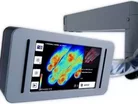Camera shows blood flow in skin to help burns victims

An innovative camera which shows blood as it circulates through the body from underneath the skin has been developed in Switzerland, BBC News is reporting.
Using laser Doppler images, the EasyLDI Microcirculation Camera is able to assess the severity of burns on the skin and has been developed by Aimago, a company based at one of Switzerland’s universities, the Ecole Polytechnique Federale de Lausanne.
The camera transmits an image of blood flow and variations in colour reflect the strength of blood circulation in the damaged skin and tissues.
To read the latest edition of Healthcare Global, click here
- ‘Healthiest’ kids cartoon character is Scooby Doo
- Nurses in Wales banned from wearing Crocs to work
- Deaths caused by malaria fall by a fifth in 10 years
Michael Friedrich from Aimago, explained to the BBC how the Easy LDI would assist in burns surgery: “Red means high blood flow, blue means low blood flow.
“Specialists can use this information to see whether the burnt tissue still has blood supply or not.
“If the tissue has no blood supply it cannot recover, it's going to die so you need to do skin grafting,” he added.
“However, if the skin is perfused and blood is still flowing through it, then it's going to heal spontaneously without scarring.”
It is thought the camera can help doctors and surgeons to decide if surgery is necessary up to three days earlier than current methods allow.
Trails have taken place at CHUV University Hospital in Lausanne, where reconstructive surgeons and burns specialists have tested the camera.
The results of the tests were presented at yesterday’s 14th European Burns Association Congress which was held at The Hague.
However some surgeons believe rival devices also featuring laser Doppler images that only provide static images are apparently all that’s needed in hospitals.
Greg Williams, the Head of the Burns Department at the Chelsea and Westminster Hospital, told BBC News: “With the laser Doppler and clinical judgement, you get it [diagnosis] right about 98 percent of the time.
“Whether this new device will offer any more advantages or not, I'd have to see the machine and compare it with what we are using.”



